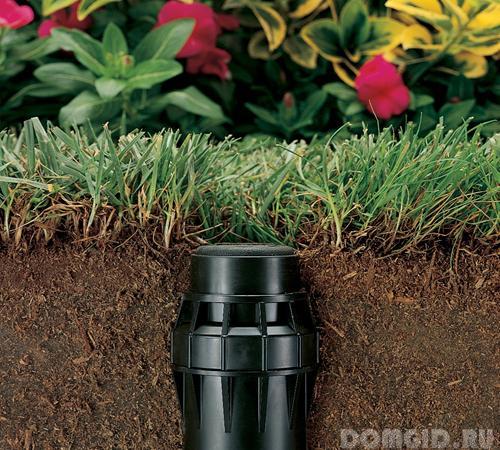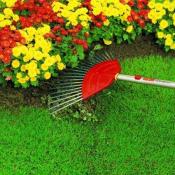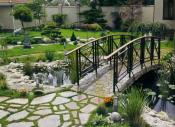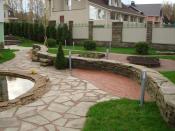Search
Login
Autowatering of a personal plot, we choose correctly, installation of autowatering, useful tips
Owners of suburban areas who had to manually irrigate lawns, gardens, gardens or greenhouses know how troublesome it is to constantly fuss with hoses, water barrels, watering cans and buckets, in addition, all procedures related to irrigation must be performed with special care - dragging hoses always associated with the danger of damage to plants. An automatic watering system installed on the site is the best option to get rid of endless troubles, in addition, you can find models of systems in the distribution network that allow for high-quality soil hydration both in slides with indoor flowers and in large areas of the entire garden or vegetable garden.
Content
- Automatic irrigation, varieties of water supply systems
- Sprinkler systems video
- What is the difference between drip systems of autowatering video
- How to control the water supply
- Semi-automatic installations
- What accessories are recommended to supplement the automatic watering system
- DIY watering video
- Auto watering indoor plants
- Some helpful suggestions
Automatic irrigation - varieties of water supply systems
The main component of the automatic irrigation system is the source from which water will come. Since centralized water supply to summer cottages is not established everywhere, the owner of the plot will first need to choose the option of supplying water to the system:
- from the well
- from a natural body of water nearby
- from the water storage tank installed on the site.
Depending on the location, automatic watering systems can be divided into underground and ground.

Installing the ground structure is quite simple, it is laid along the jitters on the beds or in the garden and connected to a water supply. Such a system attracts by its ease of operation, low cost, it does not require much time for assembly and disassembly. The use of ground-based systems is also possible when the landscape of the site is already fully formed.
But in the event that increased demands are placed on the decorativeness of the site, i.e. Owners want, for example, to get the perfect lawn on the lawn, so the kind of hoses laid on the lawn will certainly spoil the whole picture. In this case, you will have to resort to installing an underground automatic watering system.

Their installation is preferably carried out in the process of creating landscape design. Underground systems are practically devoid of flaws, they allow free movement around the territory, they do not spoil the general view of the site, the negative aspects are the considerable cost of the structure and the need to preserve it in the cold season.
Sprinkler systems

The methods of water supply in automatic irrigation systems can be different: sprinkler and drip. Sprinklers are usually used when necessary to water plants with a shallow root system, for example, lawn grass. The advantage of the sprinkler is that the water is supplied in small drops that do not injure the plant. Irrigation rain systems can be static or dynamic.

The first ones have the form of an umbrella, the radius of the surface irrigated by them is about 5 m, the second, with a radius of action of 5-35 m, are characterized by a slow feed of a rotating water stream. The ability to adjust allows you to irrigate a strictly limited area, which gives considerable savings in water. In addition, there is the possibility of changing the radius and nature of the spray of water - for this you just need to replace the nozzle. When watering a large area, such a system allows you to simultaneously use more than 10 sprinklers in one line.
What is the difference between drip systems of autowatering

If plants in need of watering have a deeply located horse system or it is undesirable to get water on their stems and leaves, it is recommended to install drip irrigation systems. With their help, it is possible to organize a dosed supply of moisture in a certain period of time, water is supplied directly to the roots of plants. Drop droplets or dispensers are placed both above or below the surface of the soil.

With the help of such a system it is convenient to autowire greenhouses, areas located on slopes or terraces. Using a drip system allows you to save water, you can operate it for many years, in the work it manifests itself as reliable.
How to control the water supply

In automated irrigation systems, a programmable electronic unit is used to control water flow, it can be installed on the street or in the house. If desired, you can choose a system with portable control. The controller allows you to perform:
- turning on, turning off the pumps,
- opening or closing magnetic valves for water supply,
- control the time of watering.
To control the most modern systems, you can use a mobile phone or the Internet. This is extremely convenient for those owners of country houses who periodically have to live in their city apartment periodically in the summer.
Semi-automatic installations

Irrigation systems can also have a simpler, semi-automatic design. It is much cheaper because it does not include a programmable controller, weather sensors and solenoid valves. Such a system consists of a node connecting to the water supply system, pipeline, valves and sprayers. Such a system will work only with the direct participation of a person who needs to open the valve to start it. But with a permanent residence in a country house this will not constitute any particular inconvenience. Those. if there is no possibility to constantly look after the irrigation system, then you should pay attention to automated systems.
What accessories are recommended to supplement the automatic watering system
One of the most useful additions will be a soil moisture sensor. With its help it will be easy to determine the soil moisture in the beds. It will also be an indispensable device in greenhouses in which drip systems are used. By turning on a light bulb of a certain color, the sensor will signal a lack or excess of moisture in the soil, this will be a signal to start or stop the system.

No less important in open ground conditions will be rain sensors - at their signal, with the onset of precipitation, the controller will turn off the automatic watering system. As a result - saving water resources and preventing excessive soil moisture - for some plants it is undesirable.
DIY watering

An automatic watering system can be purchased ready-made, but if you wish, and knowledge of the basics of design, you can create it yourself. The production process will look like this in stages.
First you need to create a project:
- draw a plot on a scale,
- calculate the absolute overlap of the area and place sprinklers on the plan,
- taking into account hydraulic losses and flow rate, divide the irrigation system into zones,
- determine the parameters of the water tank and select a pump of the appropriate capacity,
- determine the type of connection of couplings, filters and fittings, calculate their required number.

Further, the project can be put in kind:
- mark the area accordingly
- mark the place of digging trenches,
- to exclude irrigation of excess territory, it is necessary to very accurately determine and mark the location of sprinklers,
- in the marked places, trenches should be dug, their section should be 30x20 cm.
If the work is carried out on the finished lawn, then it will need to be removed and stored, dumping of the dug soil should be done on a piece of plastic film.
Then you can proceed with the installation work:
- assemble sprinkler assemblies, valve boxes, pump and reservoir,
- using fittings, connect the pipeline to the assembled nodes,
- make piping of the pump and water tank,
- pass the power cable, connect the control panel to it, configure the system. After that, you can do a test run.
Auto watering indoor plants

Irrigation systems can be used not only for automatic watering of a lawn, garden or garden - they are very popular among lovers of indoor floriculture. The simplest do-it-yourself watering system is a bottle filled with water and having a hole in the lid. It is installed with the hole down, water from the bottle will very slowly flow out and soak into the soil.
The simplest but industrially manufactured watering system for indoor plants is a flask filled with water, connected to a ceramic sock immersed in the ground. When the container is empty it is filled with water.
how to organize gravity automatic irrigation

To equip this type of system, you will need:
- dropper, without tip and needles
- a piece of hose similar to that used in auto glass washer
- 5-6 liter plastic flask
- ordinary ballpoint pen.
A piece should be cut from the handle and inserted with the threaded end into the hole made at the bottom of the flask, sealed with rubber. On this home-made fitting, screw a cap with a sealing washer and a cut off tip from the inside - water will flow out through it.
On the dropper, you should cut off the hose sections with the regulator, and connect the system of tubes using plastic tees - you get a system that allows you to water several pots. To assemble the main line, you should use washer hoses, bends leading to flower pots can be made of thin hoses with fluid flow controllers. The system is connected by connecting it to a plastic tube fixed in a flask. If the hose does not fit well on the tee - it can be heated with a hairdryer.
When setting up an automatic watering system, the water tank should be installed higher than the pots with plants. In the pots themselves, watering hoses are attached to rods stuck in the ground. Hoses with regulators lead to each plant. The irrigation intensity of each plant can be dosed. It is also recommended to provide the system with a general regulator located at the outlet of the flask - it will allow watering for a certain period. If there are a lot of pots, it is better to equip several branches of the irrigation system.
automatic system

If you create an automated irrigation system, then it is better to plan one where water would be supplied automatically. To do this, you need to include a timer and a pump in the system, it can be submersible or external. Such a system will require a 12 V voltage source with a current of 4-5 A. To control the irrigation process, you will need to set a daily timer in steps of no more than 1 minute.
In order for the automatic watering system to work without a pump, it is possible to supplement it with an electromagnetic valve - by the signal of a timer it will start and stop the water supply. In this case, the water tank should be installed above the flower pots.
flower pot with automatic irrigation

An ideal option would be to buy a flower pot with automatic irrigation - among the many models it is easy to choose the right one for design. The organization of automatic watering in such pots can also be different. The technique of using a cache-pot with automatic irrigation is as follows:
- a layer of drainage is placed in a technical pot,
- plant a plant and fill it with nutritious soil mixture,
- in accordance with the instructions, water is poured into the autowatering system,
- for several weeks the plant is watered as usual,
- when the roots reach the level of moisture, the plant begins to consume moisture as necessary, independently.

Further, the task will be to monitor the level of liquid in the tank replenishing its reserves as it reaches the lower limit. Typically, this procedure is carried out every two to three weeks. Such a pot allows you to ensure the correct watering regime, without dripping moisture on the flowers and leaves.
Some helpful suggestions
It is possible to provide lawn irrigation with the help of sprinkler systems, but for shrubs, trees and plants with deep roots, drip automated irrigation should be used.
If it is not possible to constantly adjust the irrigation manually, it is better to install automatic systems.
Do not spare money on the purchase of accessories - they will help make the automatic watering system more convenient.





